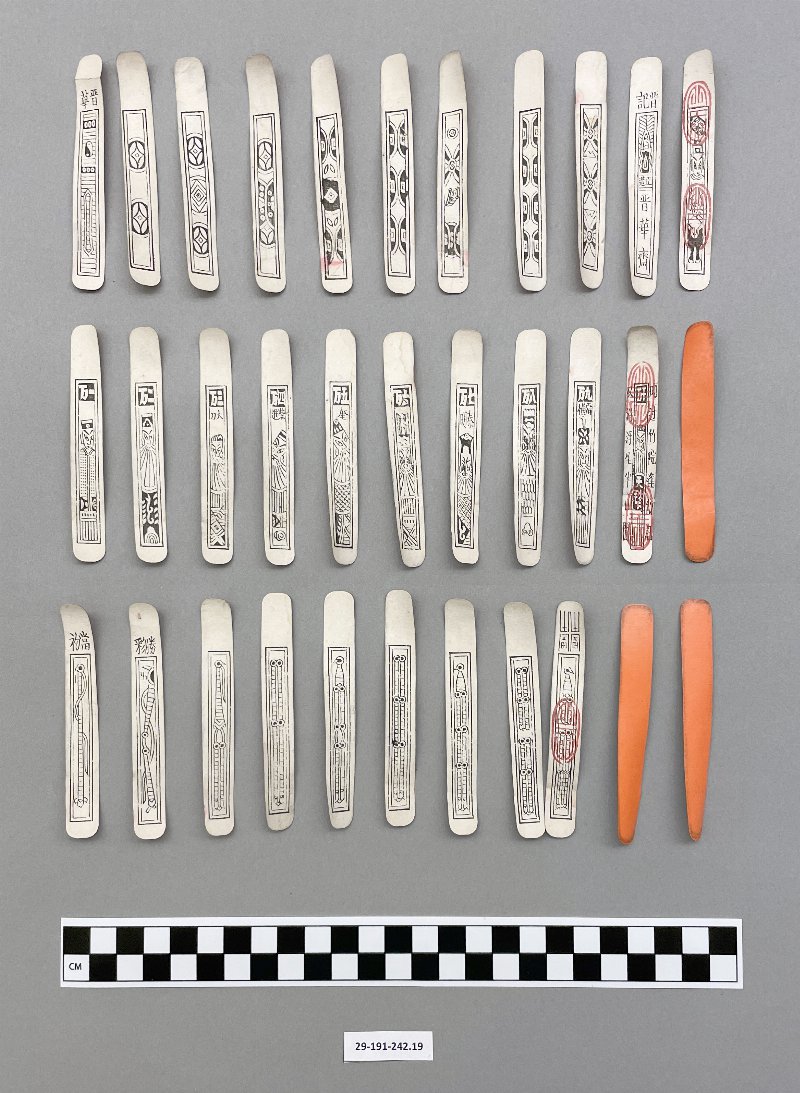| Object Number | 29-238-14 |
| Current Location | Collections Storage |
| Culture | Chinese |
| Provenience | Hong Kong |
| Period | 19th Century |
| Date Made | 1889 - 1893 |
| Section | Asian |
| Materials | Paper | Ink |
| Technique | Printed |
| Iconography | Money Suited | White Flower | Old Thousand | Wang Ying | Water Margin |
| Inscription Language | Chinese Language |
| Description | Complete deck of playing cards (120) called "Stick cards" or Gun Pai 棍牌. This type of deck contains money cards with three suits: 1-9 of cash coins, 1-9 of strings (of cash) and 1-9 of myriads. There are also three extra cards: the Old Thousand, White Flower, and Wang Ying. The myriads suit contains characters from the Water Margin story. Thier names appear on the 3, 4, 5, 7, and 9 of myriads. The 3 has 大刀 Da Dao, the 4 has 柴進 Chai Jin, the 5 has 李奎 (李逵) Li Kui, the 7 has 秦明 Qin Ming, and the 9 has 雷橫 Lei Heng. The zhihua 白花 (white flower) court card has 晋記 Jin Ji, "Jin brand", at the top, 正造 Zheng Zao, "good product", in the middle, and 晋華斋 Jin Hua Zhai, the name of the manufacturer, at the bottom. The Old Thousand court card which has 万千 Qian Wan at the top has 因过竹院逢僧話,又得 浮生半日閑, Yinguo Zhu Yuan Feng Seng Hua, You De Fusheng Banri Xian on either side of the card. These are two 7-syllable metrical lines made up of the second half of a poem by Tang poet Li She "Passing a monastery among the bamboos I spoke by chance with a monk, and achieved a half-day's respite from this vaccuous life." The phrase 天下太平 (peace under heaven) is on a coin at the bottom of the card. On the Wang Ying 王英 card is a portrait of Wang Ying with an oval above his head with characters (空湯?). The 1 of cash has the characters 晋華 Jin Hua, a brand name. The 1 of strings has the characters 當初 Dang Chu, "original" at the top. The 2 of strings has the characters 勝彩 Sheng Cai, "color of victory" at the top. The 9 of strings has 壽壽 shou shou, "longevity" on the top in a stylized script. The backs are orange. The faces are printed in black on white within a rectangular border. The Wang Ying, Old Thousand, and 9 of strings cards have red stamps on them. There are three paper bands for tying a new deck. From Culin publication: "From Hongkong. Four packets of thirty; no jokers; no index marks. Orange-colored backs. Total, 120. Fig. 127." |
| Length | 8.9 cm |
| Width | 1.2 cm |
| Credit Line | Purchased from William Henry Wilkinson, 1903 |
| Other Number | Wilkinson 14 - Collector Number | 29-191-242.19 - Old Museum Number |
Report problems and issues to digitalmedia@pennmuseum.org.


